© 2022 - All Rights Reserved
Quick links to the last few years ...
2015 pix
2016 pix
2017 pix
2018 pix
2019 pix
2020 pix
2021 pix
These are the weekly bird news break photos. Camera broke so 2022 so far is not current photos. Mostly filling in blanks of species we had not put up yet for one reason or another, and occasional reruns to show something seen currently. They are point-and-shoot study material or documentation grab-shots, generally overly tight crops to reduce file sizes, and merely for illustration. They are in reverse chronological order as used (most recent at top-start; first in Jan. at bottom-end). They were mostly taken with a Canon Powershot SX40, some with a Sony Mavica (floppy).
Note for 2022 many photos used were not from this year, but unused pix from prior years. Some few prior used ones are here and there, to show something we were seeing at the time.
filling in more blanks with better photos...

Northern Flicker come in two flavors here, formerly two species.
Yellow-shafted and Red-shafted. The underwing and undertail
are red, or yellow, and there are hybrids that are orange.
This is the Yellow-shafted type. Note yellow undertail on pic below.

They are only here in winter, are our largest woodpecker,
and they love ants, often feeding on ground. Brown above
with black barring, and boldly polka-dotted below.
Big black chest crescent (smaller sapsucker has one too).
Note wing color in flight, but many hybrids are seen.
filling in more blanks with better photos...

These are Inca Dove, one of our two small doves.
Like Ground-Dove they have rufous in wings visible in flight
above and underwing below. Inca has bold white sides to a long tail.
Ground-Dove has a short stubby tail with small white corners.
The wings click loudly like a grasshopper when flushed.
Inca Dove appears scaled with a dark margin to each feather.
(Common) Ground-Dove is plain with big black spots on wings.
Inca is often around human habitation where feed put out.
Ground-Dove does not fall for that and is a country dove.
Inca range (into Mexico) does not overlap anything Inca.
I think they used to be called Mexican Dove in some circles.

This is a Meadowlark, I think an Eastern.
They are fairly hard to tell apart, except
when vocalizing. Often called Fieldlark locally.
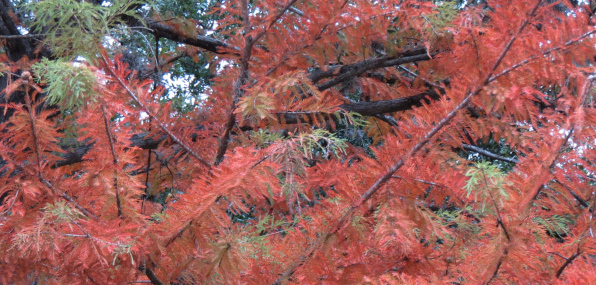
The Cypress are around peak color now and the river looks great.
This pic from a prior year.

This is Blue-eyed Grass, which is actually a tiny Iris.
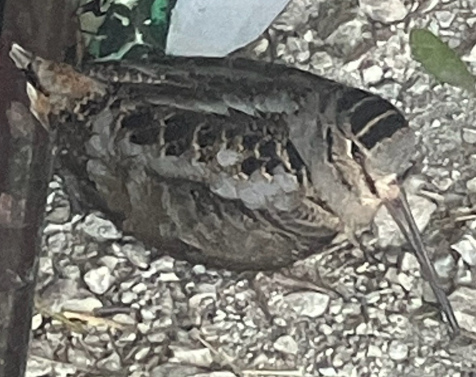
Here is a phone photo Morris Killough got of the
American Woodcock at his office on Nov. 13. Always
a great find here. This is cropped of course. I
have 5 records in 19 years here. They are a forest
woodland shorebird (sandpiper), not seen at the shore.
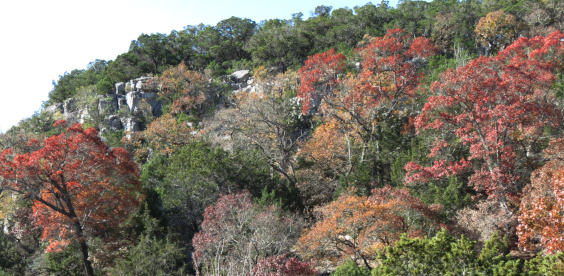
Lost Maples, Dec. 2, 2018. I just saw a pic on a park page
in which these exact Maples looked like this, right now.
The park is generally booked weekends all this month.
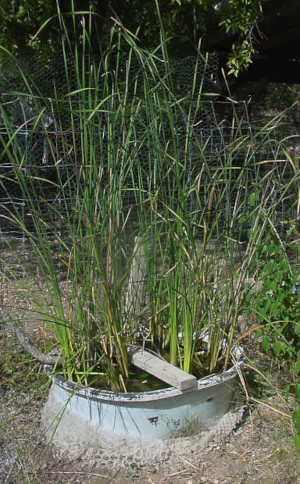
A current photo of the tub pond. In case you were
wondering how big of a marsh you needed to bring in
a Common Yellowthroat. This is 50 gallons. There is
a lily and some other aquatic veg besides the cattails
and Gambusia (mosquitofish) of course.

This is a Sphinx moth I found dead. Kathy took the pix.
No ID yet but I see these regularly here. It is a smaller
type near a couple inches long with maybe 3" wingspan.
So do you think you would spot that on the tree?
A preliminary search suggests this may be Erynnyis oenotrus.

Underside. Note the hindwing color barely shows on the
underside (ventrally), but on dorsal (upperside) is a
nice saturated burnt orange color.
Thanks to the nice lady that shared these great bat photos!

This appears to be a pair of copulating Red Bat.
This was above Vanderpool, Oct. 12.

Same pair as above.
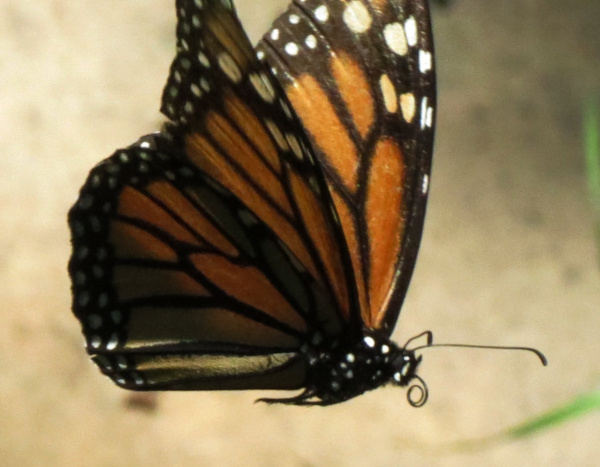
This is a Monarch in flight, which would have been
really neat if I had goten the tips of the wings.
not current photos, but of things currently out there...
these are some of the day-flying moths on flowers right now.
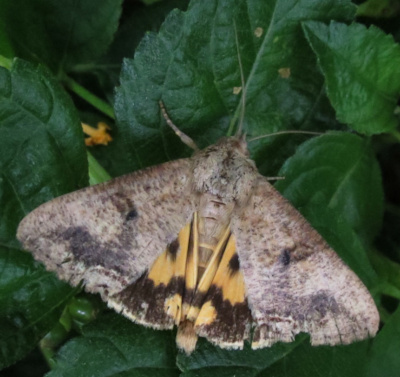
There are fair numbers of these moths on the flowers currently.
I think Hypocala andromena - Andromena Moth aka False Underwing.

There are also some of these on the flowers, which I think
are one of the Lichen Moths, c.f. Lycomorpha pholus. The
white flowers blew out the sensor and over-exposed it horribly.
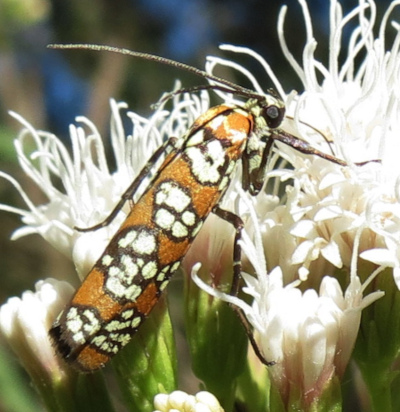
These are out on the flowers now too, the Ailanthus Webworm moth.
Again, the sensor gets blown out by white and overexposes. (Atteva punctella)

This is a Texas Wasp Moth (Horana panthalon texana),
a moth that mimics a wasp. A few of these about now too.

Here is a docushot Kathy got of the White Peacock on Sept. 26.
Mavica floppy disk pic so not overwhelming of detail, but great docs.
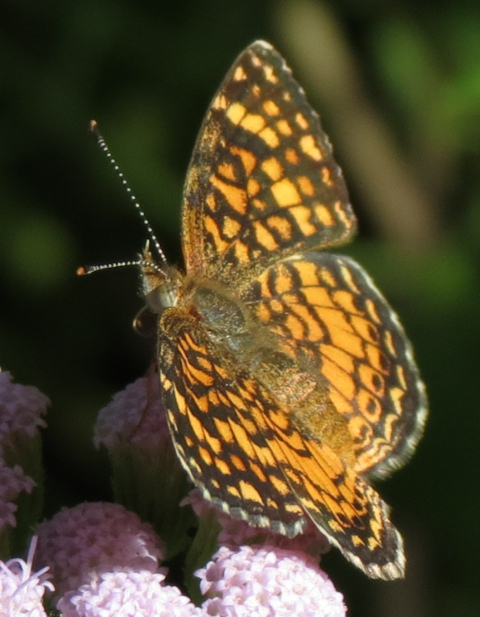
A small wavelet of Vesta Crescent seems to be showing up.
The abundant one right now is Snout, again, but I am seeing
small numbers of Vesta building on the Frog-fruit now. They are
the most common crescent here, but often as immigrants from
elsewhere, such as the Snouts are.
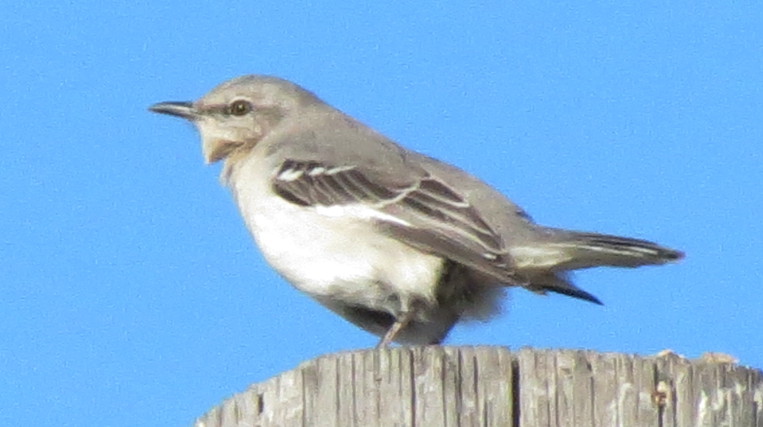
This Northern Mockingbird has molted its tail and a new
one is just growing in. Giving the usually long-tailed
bird a fairly funny bob-tailed look.
Apologies for the poor old shot... which is a
Mavica (floppy disk) digiscope.
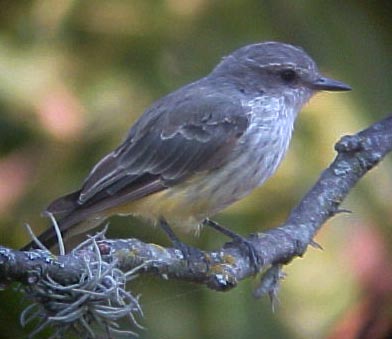
This is a juvenile Vermilion Flycatcher. At first they
are streaked on breast and a yellowish-salmon rearward below.
Not sure any of this plumage on site, so filling in holes.
Apologies if I put this up somewhere and forgot it.

Male Lesser (Black-backed) Goldfinch on Musk Thistle.
Musk is the Euro non-native introduced invasive Thistle here.
I would like the pic a whole lot more if it were on a native.
The following are not current photos, but show current events

We saw 4 Yellow Warbler at once in the bath this week.
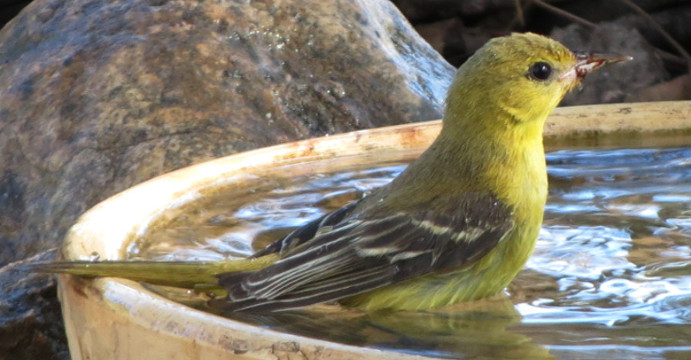
This is a fall female or immature Orchard Oriole in our birdbath.
There were three of these at once in the bath this week, and
as soon as they left 2 males dropped in to it.

This is an underexposed docushot of the immature Yellow-crowned Night-Heron at Utopia Park Aug. 12. It continues today the 19th. At least two are there now. The are white-spotted on brown above, and brown-streaked on dirty white below. Those are Cypress leaves on the water surface, as in November, usually.
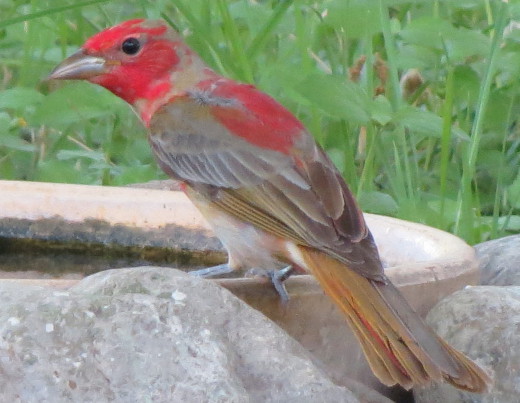
This is a first spring male Summer Tanager. They are pied with the mustard olive of an immature or female, the males acquiring red over their first summer. This was April 17, 2018, early in spring.
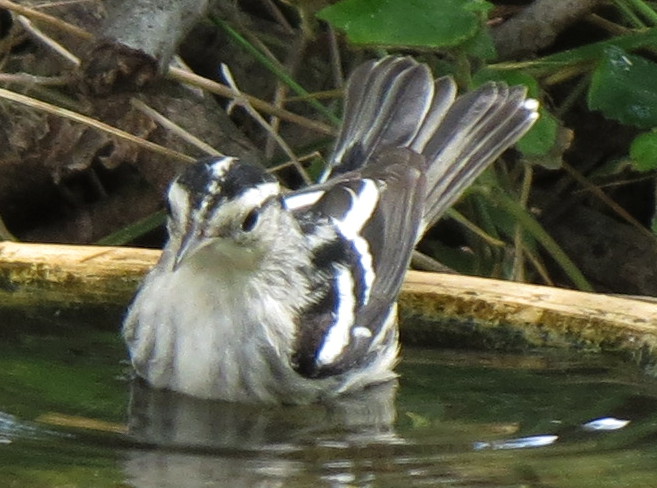
Black-and-white Warbler, female or immature.
This is what I would be doing if there was a river.
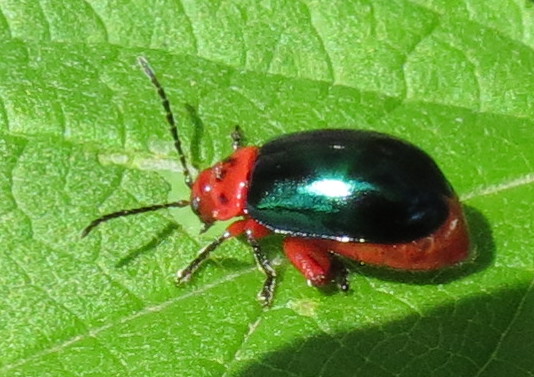
Shining Flea-Beetle eating hole in American Germander.
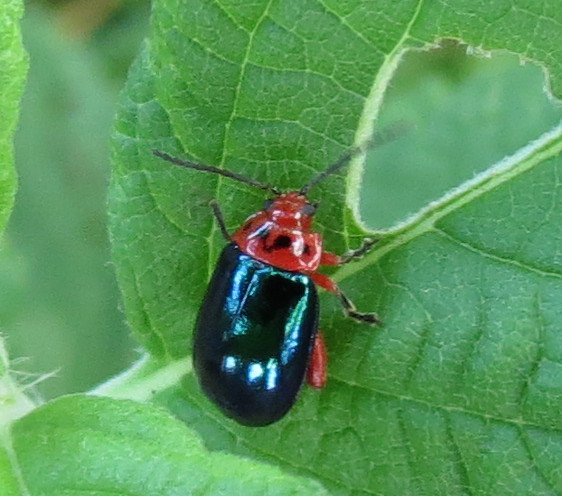
Shining Flea-Beetle still eating holes in American Germander.

Another type of Flea-Beetle with nice polka-dots.
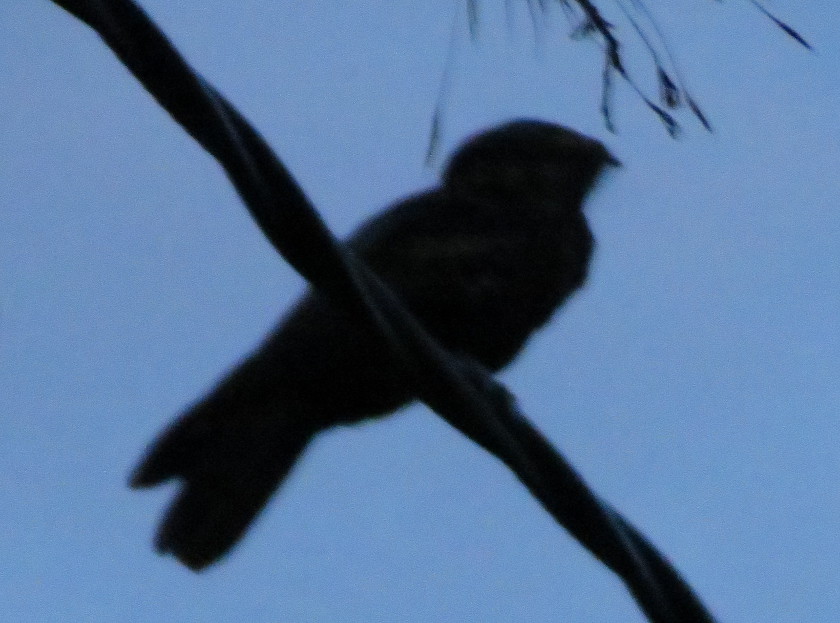
Here is a little something for all those ID whiz superstars. This is a nightjar. Your mission, should you choose to accept it, is to identify it. Two species had just called from the immediate adjacent vicinity. This bird landed on the wire, there was just a crack of light left, I had to gas the ISO up to 3200, got one shot and it split. Only had a bare-eyed view, mostly was looking at back of camera. So you know what I did at the time, the two species that had just called were N. Paraque and Chuck-will's-widow. It was Sept. 5, 2019. I think it can be ID'd based on shape and structure. Interesting to me, I had only prior seen Nighthawks (both species) sit on wires, but, I guess why not, nice perch. I will not be posting a quick answer, or best guess, leaving it up as a mystery bird for a bit.

In case you wonder what the new shoals of small surface fish
are at the park. This is the native Sailfin Molly found in
south Texas. Male has blue in tail and orange-yellow head,
both of which can get quite bright in breeding season. The two
upper fish in rear are females. These are the Leona River
individuals, which I kept and bred years ago.

Hutton's Vireo Oct. 6, 2019.
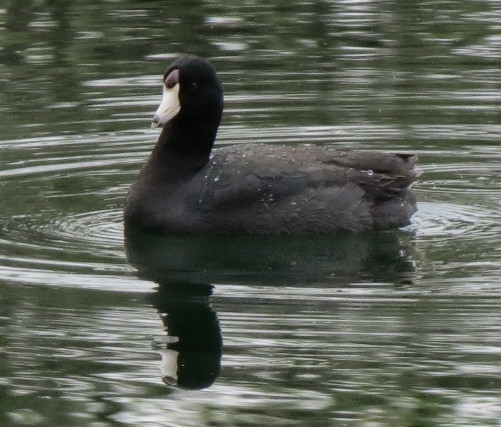
This is a Coot, taken at Utopia Park March 24, 2018.
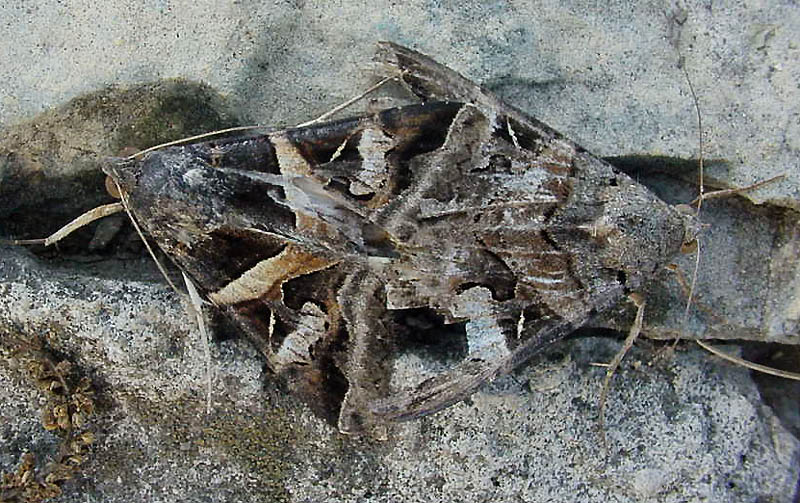
Kathy took this pic of a pair of mating moths.
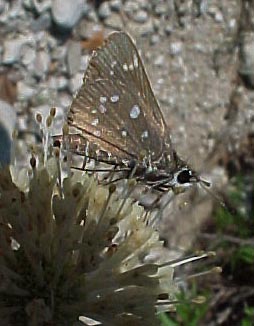
Dotted Roadside-Skipper, June 28, 2009.

One of the Ghost Moths methinks.
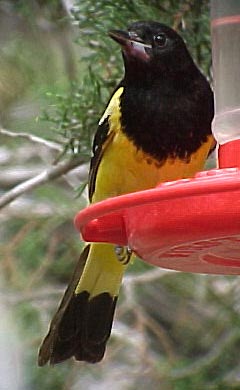
Male Scott's Oriole

Tropical Checkered-Skipper, taken July 16, 2019.

This is the Cerambycid (Longhorn) Beetle from a
couple weeks ago (May 21). Elytrimitatrix undata is
what it looks like to me. Based on Mike Quinn's
most excellent Cerambycids of Texas webpage.
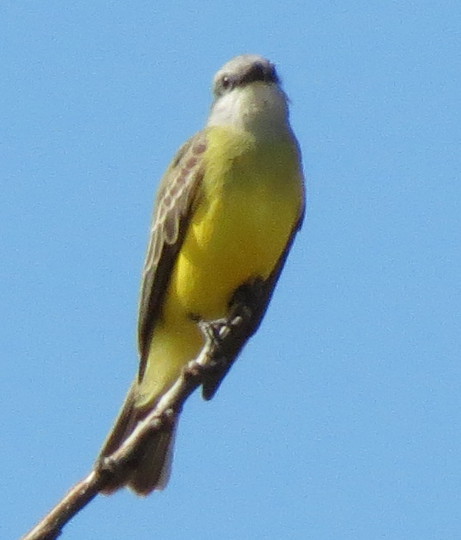
This is a Couch's Kingbird from a few
winters ago. The pair that we first saw in late
April came through our yard again this week.
I would say nest-site prospecting in the valley.
They nested at very SW corner of town in 2006.

This is the Little Blue Heron that was
at the park for several days.
Kathy chisled
these pixels onto a floppy disk with the Mavica.
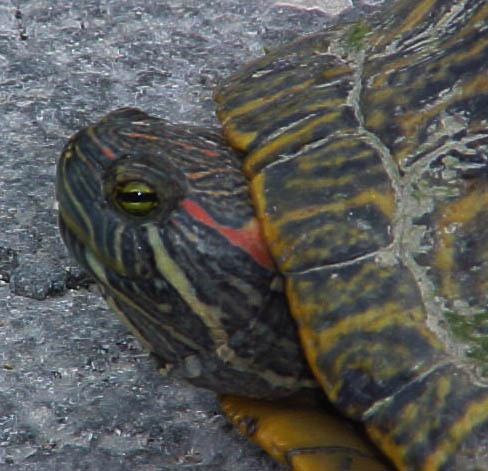
Red-eared or Pond Slider are probably the most used names for this turtle. Texas River Cooter is the other regular type found locally. It is less green without yellow marbling on carapace (top half of shell) and much darker, almost blackish, with only a little yellow on head. It is also not as domed of carapace, so a much flatter shape, better for speeding in the river.

This is a Catbird at our birdbath 2 falls ago. The one at bath today looked the same. ;) In early May watch Mulberries for them, and thrushes, grosbeaks and orioles.

A male Painted Bunting. You should be seeing some now. There has been a great wave of them moving through. We had 16 adult males at once (!) in the past week, likely more were around yard we missed in the moment count. They love white millet, and-or a birdbath, but keep it clean if you do that. (the 16 at once count was 3rd week of April)

This is an Underwing (Catocala sps.) moth of some flavor.
Apologies if this is up and you have seen it before.
There are a bunch of types, I think a half-dozen or so,
at least, here. The hindwing on several types is bright red,
orange, or pink, but the most common one is brown.
They are all flavors of incredible camo above. In flight
the hindwing is stunning if a colored type, and the wingspan
is 2.5" so it is a good sized moth.

This is a Solitary Sandpiper a couple springs ago.
At the small south pondlet on S. Little Creek Rd.
Just one, alone, solitary, as they usually are.
One flew over the house calling April 3 this week.
Only life bird I got from horseback (1973, Big Pine, CA).
This is a real virtual artificial reality simulation of our FOS Golden-cheeked Warbler that bathed and preened on Mar. 27th here. These are (unposted prior) photos of another male that did the same thing a couple years ago.

A male Golden-cheeked Warbler puttin' some water up.
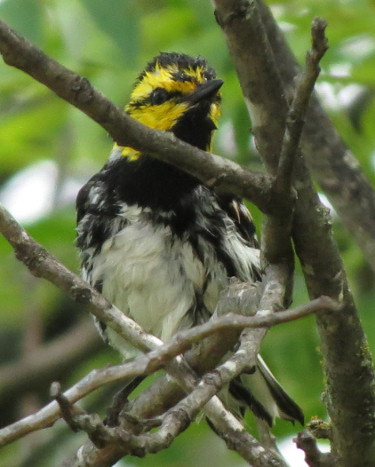
Soaked and preening in the Pecan over the bath.

Soldier Fly of the genus Odontomyia on blooming Antelope Horn.
~ ~ ~

This is an Anemone. They should be sprouting soon in your
yard. But most are white. Some are purple, and rarely
I see one of these pink ones.
~ ~ ~
And now for something completely different.
This is a satellite pic of the yard and vicinity to give a better idea of the immediate environs for much of what is being reported here. This is the observation station. Pic in winter however so fairly leafless and devoid of vegetation compared to lush spring and summer. Only the Live-oaks and Junipers have foliage. As you can see the traffic gets pretty backed up. The other day I saw 8 pigs, 6 deer, a coyote, and two rabbits had to wait for a dillo to cross the road.

The left-pointing triangle at center is the two acre hog-fenced plot we live on. The bare dirt treed area to south of house (toward bottom) is the corral, then the tip of the grass airstrip is bottom center. Yes, you can fly in. Left of house the greenery is huge ancient Live-Oaks on a slope with Mountain Laurel and Agarita, the hill country. North half of north fenceline is Junipers and Mesquite. Across from the gate are big climax Mesquites (brush country), those are Junipers towards river from them. The yard has 7 big Pecan trees, more smaller, and lots of what is leafless in corral is Pecans (deciduous woodland). There are many dozens of Hackberry trees throughout. River is Cypress lined, nearest one just over 100 yards from gate. So it is a remarkable confluence of habitats in one place. This is what a 230 species yard list yard looks like in winter. Would love a summer shot.
~ ~ ~
A big bonus break while we are talking tinkering ...
I will be putting a separate page up for this.
Meanwhile, here is my blindowscreen™.
I replaced a standard window screen with this
so I could photo birds at the bath from inside
the house without shooting through screen.
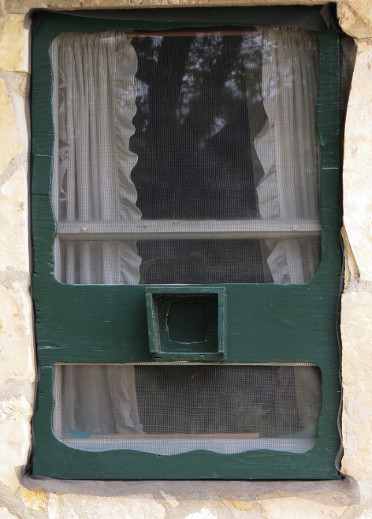
It is screen above and below the solid part below center,
which has the window in it to poke the lens out. The little
box is a rain, sun glare, and hide-lens-movement shade.
With house window open, we can access the shootin' hole.
This is why so many bird bath photos litter the pages.
You might recognize the big rock at 11 o'clock to the
bath, it has the biggest list of all the rocks. Always have
good cover next to any bath, note big stick pile for safety.

This is what the view looks like from the inside.
Have better pics, will replace this with one someday.
The white at left edge is the slat that opens window up.
It slides on two tracks (one visible at bottom of frame).
The tracks and slat are cut at matching 45 deg. angles
to keep slat tight against hole so no bugs can get in.
No spigot on that side of house so we have to slum it
with a milk jug for a drip. The birds don't care.
~ ~ ~
I will be putting a separate page up for this. This is the knothole nestbox™ I made, before it was sanded, burnt and varnished, when being fitted.

The branch stub is a foot deep, which I had to chisel,
grind, cut, saw, stab, bust knuckles, etc., to
make a good nestbox sized cavity in. The interior of
an old stub like this is roughly the same strength
as zircon encrusted titanium over the best tempered
steel.

This is the coonscluder™ I made for it. This
could be used on any nest box. It deflects the coons
grab wasting half the arm reach, leaving too little
to reach the nest. Also using a thicker piece for front
helps waste the reach, forcing a straighter approach angle,
and directing that reach straight into the deflector.
Leave enough space for the bird to get around it easily.
There currently seems to be only one coonscluder™ in the world.
~ ~ ~

Sorry about the fuzzy photo. It was across the pond at
the park a couple years ago. There were 33 of these
at the park today, half were males like this, females
are brown. This is a Ring-necked Duck. Named after
the part that is hardest to see. The ring is at the
base of neck and requires good light to see. Ring-billed
Duck would have been better. In good light the head
is iridescent purple. The white side is blown out
due to over-exposure, actually they just have a white
veritical bar at front of that white area, which is
otherwise pale gray in reality.
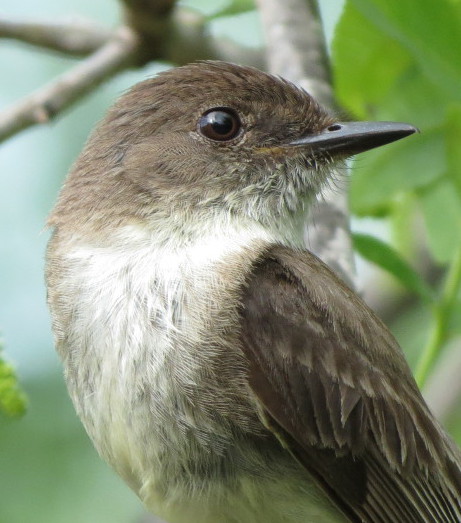
This is an Eastern Phoebe, one of our nesting pair.

This was Feb. 15, 2021, last year. No snow, not quite as cold
in the event this week, and the power grid held. We had ice
and probably graupel this time, and some single digit chills,
mornings in 20's dF with howling winds on it, and not
breaking freezing all day.
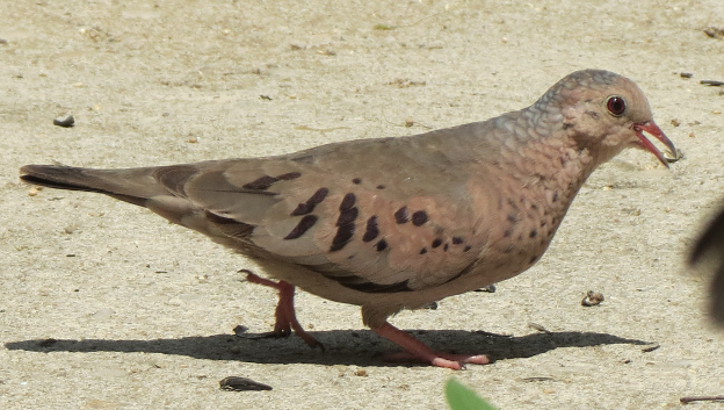
This is an adult Common Ground-Dove. They have become scarce here lately.
The black spots on the wing iridesce neon purple with sun at just right angle.

Black-crested Titmouse, adult
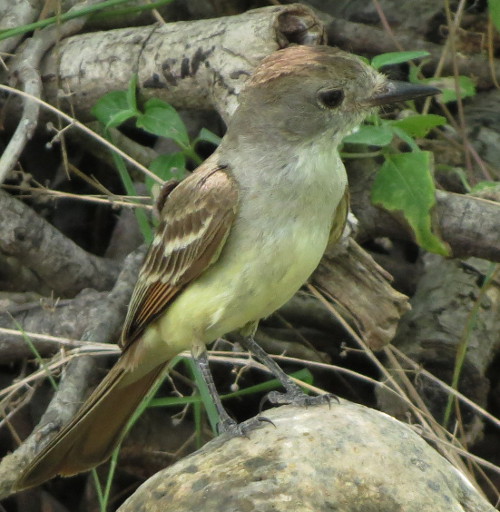
This is an Ash-throated Flycatcher. Not sure we have a
pic of one up on the site, so here ya go. Trying to fill in
some holes and gaps. Of the three Myiarchus flycatchers
that nest here, this is the common one. The tail is mostly
rufous like that bit (primary edges) in the wing.
~ ~ ~

Just to give an idea, here is a pic showing part of the yard, house and cottage, so you can get an idea of where much of the stuff being written about is being seen. This pic was May 2013, barely two months after we moved into this place. Now there are butterfly flowers around the porch and in flower beds. The yard lists are: 45 species of odes (dragons-damsels), 98 sps. of butterflies, 7 sps. of frogs & toads, 7 sps. of native lizards, 8 sps. of native snakes (two more out on the road), 20 sps. of native mammals, about 100 sps. of plants (mostly native wildflowers), and now at the 9 year point, about 230 native species of birds.
Quick links to the last few years ...
2015 pix
2016 pix
2017 pix
2018 pix
2019 pix
2020 pix
2021 pix
If you have arrived here from our Bird Photos page, you may close your browser to return to the Bird Photos index.
Other visitors may click your "Back" button on your browser or select a link to keep visiting!

To Bird Photo Main Menu

To Butterfly Pics

To Dragonfly & Damselfly Pics

To Current Bird News
Birds
Utopia Birds
Birding Sites
Bird List
Bird Guide
Reports from Lost Maples
Winter Bird Count
Butterflies
Butterfly News
Butterfly List
Butterfly Photos
Rare Butterflies
Dragonflies
Critters, Bugs, & Stuff
Lost Maples
Garner State Park
Local Site Guide
Home

Our E-mail
mitch @ utopianature.com
 All photographs within this site are copyrighted
All photographs within this site are copyrighted